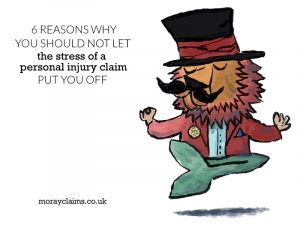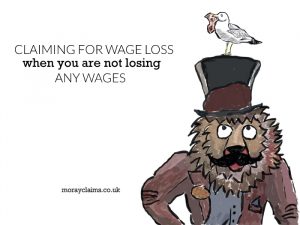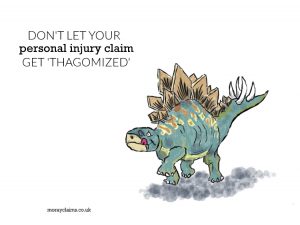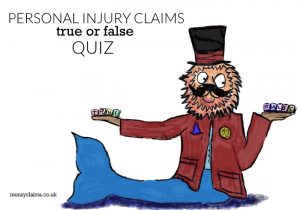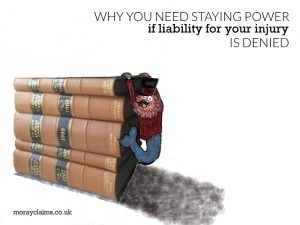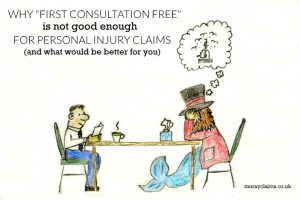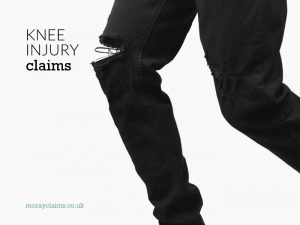We get stressed about money, reputation, safety, relationships, life changes… Life changes are a journey. And they’re journeys that usually involve stress. By the end, you're a different person. Both elements – change and stress – play their part in the transformation process. Personal injury claims are stressful. In this article, we’ll look at the nature and causes of the various stresses. Then, having considered these ‘problems’, we’ll list out the ‘solutions’ - the reasons why, nevertheless, you should go ahead with a personal injury compensation claim. Getting injured creates its own acute stress at the time. Often, there’s immediate severe pain. Beyond that, you have a loss of independence – with increased dependence on others. And also fears for the future: will you recover to full fitness? Most people seek legal representation for a personal injury compensation claim after the acute phase of the injury is over. Perhaps after you get out of hospital or after you Continue Reading
Articles from our blog on the Claims Process
Below are articles from our blog which relate to the topic of the Claims Process.
Please also see our main page on the Claims Process
Claiming for wage loss when you are not losing any wages
You don’t usually get something for nothing. We’ve talked about that issue before when answering the question: How does your personal injury solicitor make money if they do not charge you anything? In the context of a personal injury compensation claim, claiming for wage loss when you are not losing any wages sounds like getting something for nothing – getting a windfall - but it’s not like that at all. To understand how you might claim for future wage loss when you’re not currently losing any wages, we need to consider 3 things, which we’ll do in the remainder of this article. Firstly, how is wage loss normally calculated? Secondly, in what circumstances, might you be able to claim wage loss when you’re not losing any wages? And, finally, how is the calculation made? Let’s look at wage loss claims generally, for a start. If you have a personal injury claim, wage loss may be an important part of your claim. It may be the main reason you decided to make a claim at Continue Reading
Don’t let your personal injury claim get thagomized (by getting a move on now)
Do you know what a thagomizer is? The thagomizer is an arrangement of 4 to 10 spikes on the tails of dinosaurs such as the Stegosaurus. The pointy bits provided a defensive weapon against predators. Stegosaurus was a herbivore. With a toothless beak and small teeth, it was not designed to eat flesh. Legendary cartoonist, Gary Larson, coined the term ‘thagomizer’ in his 1982 image of a caveman giving a PowerPoint presentation to colleagues and telling them it was so-called “after the late Thag Simmons”. Poor Thag. ‘Thagomizer’ has come to be adopted as an informal anatomical term. It’s used on the Stegosaurus display at the Smithsonian Institute in Washington D.C.. Clearly, Stegosaurus had a mighty sting in the tail, if required. Personal injury claims can have a sting in the tail too, if you don’t watch out. The cruel defence is one of ‘delay’. Wait too long and your claim will become unenforceable and lost forever. As we have discussed elsewhere, the Continue Reading
Personal Injury Claims True or False Quiz
Here are 12 questions about personal injury claims in Scotland. There are some local, Moray elements thrown in too. This covers things like: At the end, we'll tell you your score and the answers. Should have any questions at all, please get in touch with us. All enquiries are free of charge and without obligation. See the article HERE, if you want to understand more about what will actually happen if you get in touch with us about making a personal injury compensation claim in Moray. Continue Reading
Why staying power is important if liability for an accident is denied
This is a case study of an injury claim arising from a pavement tripping accident. We’ll go through the stages of the claim from intimation of claim to the point where insurers admitted liability. It was not a straightforward process. In our experience, that is not unusual. We hope this will give you an illustration of what can happen with a personal injury claim for tripping injuries. The facts show why perseverance with a claim may be necessary. Here’s a photo of the pavement where the injured person fell. At the time of the accident, the injured person was walking into the photo (i.e. away from the cameraman). The injured person's left foot went down on the edge of hole at a point where it was about 3cm deep. This caused them to go over on their left ankle and suffer an inversion injury to it. Scottish local authorities generally have a duty to repair pavement defects once they produce a height difference of more than 2cm (20mm). This is a height difference Continue Reading
Should you accept the insurers’ first offer?
Sylvester Stallone’s big break as a movie star came with the 1976 film, Rocky. However, his own story is as inspirational as that of the boxer he played on screen. Stallone had a troubled upbringing, spending a lot of time in foster care. In his 20s, at one point, he was so hard up that he had to sell his dog. He wrote the first draft of Rocky after watching a boxing match in which an unknown and unfancied fighter lasted a full 15 rounds against world champion, Muhammad Ali. Film studios were very interested in the script but not with Stallone in the starring role. Nevertheless, he held out. Even when one studio offered him $325,000 for the script alone - at that time, the highest amount ever offered for a script – he did not waver. In the end, he got his wish. The purchase price for the script was only $35,000 (and the movie was reduced to a low budget production) but Stallone got the lead role. Rocky was a massive hit, winning an Oscar for best picture - and Continue Reading
When you need to get copies of your Medical Records (Pitfalls to avoid)
“Can he really play?” “Heavens, no! He never played a note in his life” That’s the caption accompanying what is reckoned to be one of the most copied advertisements in history. The headline? "They Laughed When I Sat Down At The Piano - But When I Started to Play!" This 1927 newspaper masterpiece by John Caples has become a prime example of how to sell to people by tapping into their emotional desires through storytelling. The long-form advertisement was to promote a (free) book entitled “Music Lessons in Your Own Home”. Even the legendary comedian, Bob Monkhouse, copied the format for one of his best gags: “When I first said I wanted to be a comedian, everybody laughed. They're not laughing now.” Copying others’ style can apply whether you are writing an advertisement or a joke. Copying can also apply to medical records – and that’s what we’re looking at in this article. We’ll consider three questions relating to medical records in personal injury Continue Reading
Why First Consultation Free is not good enough for personal injury claims (and what is better for you)
Is one font better for your memory than another? Can the design of the typeface used to put information into a readable form make a difference to how well you will recall that information later? Research on this issue at RMIT University in Melbourne concluded that most of the fonts we see every day are similar. Their familiarity means we often glance over the words they form and no memory trace is created. On the other hand, at the other end of the spectrum, if typography is too different from the norm, the brain does not process it well and, again, we don’t retain the information. Is there a way to overcome this balancing act between over-familiarity and unreadableness? RMIT has developed the font, Sans Forgetica, which could be the answer. They say it lies at a sweet spot where, although the appearance of the font forms something of a barrier to the learning process, overall it helps the learning process rather than hindering it. They have proved this via a mixed lab Continue Reading
Can insurers change their mind about settling your claim (if liability is admitted)?
Some say The Blue Nile are the greatest ever Scottish band. Though they only ever released 4 albums - between 1984 and 2004 - they maintained a consistently high standard throughout. Their music has a spare, cinematic quality which blends perfectly with Paul Buchanan’s soulful and world-weary voice. The Blue Nile’s 1989 release, Hats, has topped some polls to find the best Scottish album of all time. I listened to that album a lot when it came out - I was a student then - and I still listen to it often even now. The fact is, they almost never got a recording contract at all and took an unusual route to achieve that end. Around 1983, a top-of-the-range Glasgow-based hi-fi company called Linn Products found that their equipment’s sales prospects were boosted if they used music from the band’s demo tape when demonstrating Linn’s music systems to potential customers. When Linn discovered The Blue Nile were unsigned, they decided they would sort them with a record deal by Continue Reading
3 ways to maximise the power and benefit of important evidence
Memory scientist, Julia Shaw, gave a talk at TEDx London in July 2018 about reporting harassment and discrimination in the workplace. Dr Shaw is an honorary research associate at University College London in the Psychology and Language Sciences department. Women, people of colour and people who identify themselves openly as part of the LGBT community are most at risk of harassment and discrimination in the workplace. Some studies have shown that as much as 98% of affected persons will never report this type of mistreatment to their employers. One barrier to speaking up is the fear that it will be held against us and affect our future prospects in the job. Another is the fact that, often, your memory is the only evidence you have of what happened. Will that be enough to be believed? Dr Shaw has researched – in courtrooms as well as laboratories - how humans process memory of important and emotionally-charged events. The interview process is important. By “interview”, Continue Reading
Knee injury compensation claims
Dr Carl Wunderlich, who died in 1877, is famous for his measurement of average healthy body temperature of 37°C. (98.6°F). Using a thermometer reputedly a foot in length - and needing 20 minutes to register the temperature – he tested around 25,000 patients and took over 1 million readings. He was at the forefront of medical science for his time but his “normal body temperature” of 37°C has gradually been seen as an oversimplification of reality. In fact, normal temperature is actually a range because no two human bodies are the same. In addition, we all react differently to external factors and disease. Body temperature can also vary according to: how much we’ve eaten; our stress levels; hormones; and different levels of exercise. Something – normal body temperature - that, at a glance, seems simple turns out to be much more complicated. And this is also the case with the human knee. On the face of it, the knee simply joins the top of the leg with the bottom of the leg. Continue Reading
Can you make a personal injury claim if you definitely don’t want to go to court?
Tilley hats might be the best in the world. They’ve been called “legendary” and “iconic”. Tilley hats float and, if lost or stolen, can be replaced for half their full purchase price. Should the hat wear out due to normal wear and tear, poor workmanship or faulty material, it will be repaired or replaced free of charge. Tilley hats are guaranteed for life. In 2013, a Guardian reader reported that, when the fabric of their hat split after 17 years, Tilley still honoured the lifetime guarantee and replaced it. They’re expensive hats but the various risk-reversal elements clearly help keep them desirable purchases. A guarantee can make a big difference to how likely we are to choose a product or service. In the context of personal injury compensation claims, not everyone wants to have their day in court. On the other hand, in another article on this website, we’ve considered the pros and cons for those who want a guarantee that their personal injury claim’s outcome will be Continue Reading
